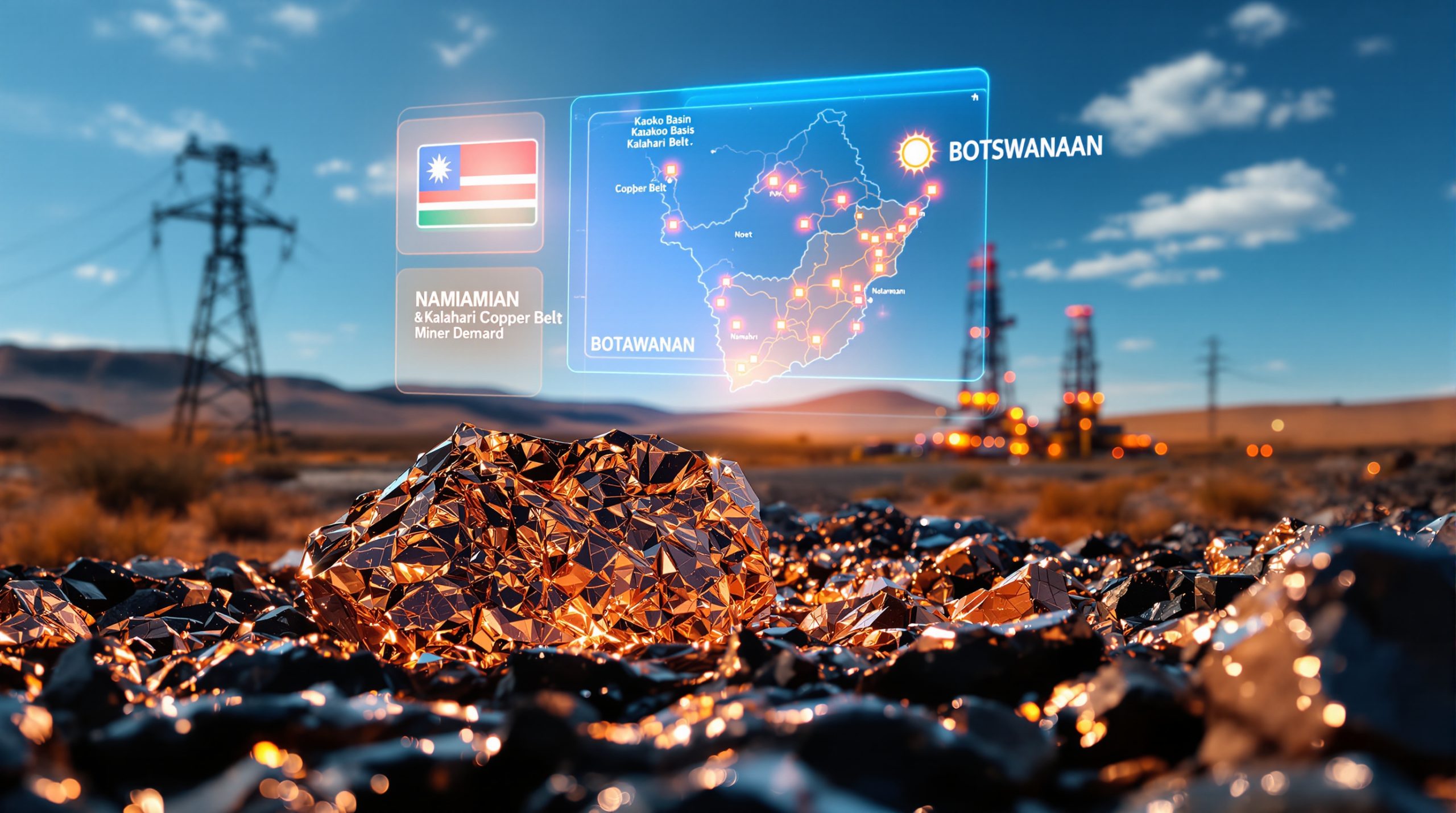Argentina's Cauchari-Olaroz Lithium Project: Ambitious Production Expansion Reshaping Global Supply
Argentina's lithium industry stands at a pivotal moment as the country cements its position as the world's fourth-largest lithium exporter. The Cauchari-Olaroz project, situated in the mineral-rich Jujuy province, represents a cornerstone development in Argentina's expanding lithium sector. This ambitious project lies within the renowned "Lithium Triangle" that spans Argentina, Chile, and Bolivia—a region containing approximately 52% of global identified lithium resources according to the U.S. Geological Survey.
How Is Argentina Positioning Itself in the Global Lithium Market?
Argentina has strategically leveraged its vast lithium brine resources to establish itself among the world's leading lithium producers. The country produced approximately 33,000 tonnes of lithium carbonate equivalent in 2023 according to the USGS Mineral Commodity Summaries, placing it fourth globally behind Australia, Chile, and China.
Argentina's Lithium Landscape and Strategic Advantages
The country currently hosts six operational lithium projects with several more in development phases. Argentina's position within the Lithium Triangle provides it exceptional geological advantages, with the region containing some of the world's largest and highest-quality lithium brine mining techniques.
The Argentine government has implemented significant investment incentives through the Large Investment Incentive Regime (RIGI). This program offers 30-year tax stability for projects exceeding $200 million USD, including reduced income tax rates of 25% and exemptions from import duties—creating one of Latin America's most favorable lithium industry tax incentives environments for mining projects.
Argentina's lithium sector benefits from several competitive advantages:
- Extensive brine resources with high lithium concentrations
- Lower production costs compared to hard-rock mining operations
- Favorable government policies designed to attract foreign investment
- Strategic location for serving both Asian and North American markets
- Growing technical expertise in brine-based lithium extraction technologies
What Makes the Cauchari-Olaroz Project Significant?
The Cauchari-Olaroz project stands as a flagship lithium development in Argentina's northern region. This large-scale operation represents a strategic partnership between Lithium Argentina (a dual-listed company on Canadian and U.S. exchanges) and China's Ganfeng Lithium, combining North American capital with Chinese technical expertise and market access.
Current Production Capabilities and Export Profile
As of 2024, Cauchari-Olaroz produces approximately 25,000 tonnes of battery-grade lithium carbonate annually. This output is currently distributed through established off-take agreements, with 80% exported to China and 20% to Thailand through partnerships with Ganfeng and Bangchak, a Thai financial backer that provided critical early financing.
The project's significance extends beyond mere production numbers:
- It represents one of Argentina's largest foreign direct investments in mineral extraction
- Demonstrates the viability of large-scale lithium brine operations in the region
- Establishes a model for international partnership in critical mineral development
- Provides substantial foreign currency generation for Argentina's economy
- Creates skilled employment and technical capability development in the local workforce
The Ambitious Expansion Roadmap for Cauchari-Olaroz
The expansion strategy for Cauchari-Olaroz aims to more than triple current production capacity by the end of the decade. This phased growth plan represents one of the industry's most ambitious scaling efforts in South America.
Triple Production Strategy Timeline
The project's expansion follows a clearly defined trajectory:
| Timeline | Production Target | Increase Factor | Implementation Phase |
|---|---|---|---|
| 2024 | 25,000 tonnes | Baseline | Initial production stabilization |
| 2025 | 30,000-35,000 tonnes | ~40% increase | Optimization of existing systems |
| 2027-2028 | 50,000-60,000 tonnes (est.) | ~140% increase | Infrastructure expansion phase |
| 2029 | 85,000 tonnes | 240% increase | Full capacity realization |
According to Executive Vice President Ignacio Celorrio, the project is on track to achieve this substantial growth through phased expansion and technological improvements. The expansion will leverage existing infrastructure while incorporating advanced extraction and processing methods developed specifically for the unique brine chemistry at Cauchari-Olaroz.
Implementation Strategy and Investment Framework
The expansion strategy encompasses multiple dimensions:
- Optimizing current operations to reach full design capacity through process refinements
- Implementing staged capacity increases with minimal production disruption
- Applying for benefits under Argentina's RIGI program by the end of 2025
- Utilizing tax advantages for investments exceeding $200 million
- Securing foreign currency inflows to support Argentina's macroeconomic stability
The expansion requires significant capital investment, with the financing structure likely to include a combination of reinvested operating cash flow, strategic partner contributions, and project financing. The stable regulatory framework provided by the RIGI program is expected to be instrumental in securing the necessary investment capital.
Advanced Technologies Driving Production Growth
The Cauchari-Olaroz expansion incorporates several technological advancements to improve efficiency, sustainability, and product quality. These innovations address the unique challenges of brine-based lithium extraction in the high-altitude Puna region.
Brine Extraction and Processing Innovations
The project's technical leadership is implementing:
- Advanced brine concentration techniques using selective absorption technologies
- Optimized evaporation pond systems with enhanced weather monitoring and management
- Enhanced lithium carbonate purification processes to maintain battery-grade specifications
- Water recycling and conservation methods to minimize freshwater consumption
- Energy efficiency improvements including renewable power integration
- Digitalization of production monitoring and quality control systems
These technological enhancements serve multiple objectives:
- Increasing lithium recovery rates from the brine resource
- Reducing production cycle times between extraction and finished product
- Maintaining consistent battery-grade quality specifications
- Minimizing environmental footprint, particularly water consumption
- Optimizing operational costs to maintain competitive positioning
The Pozuelos-Pastos Grandes Joint Venture: A Parallel Development
In August 2025, Lithium Argentina and Ganfeng announced a significant new joint venture called Pozuelos-Pastos Grandes. This initiative consolidates three projects in Argentina's Salta province into a unified development with ambitious production goals.
Project Integration and Production Objectives
The Pozuelos-Pastos Grandes consolidation includes:
- Pastos Grandes project assets
- Sal de la Puna development area
- Pozuelos lithium tenements
This strategic consolidation creates substantial synergies through:
- Unified water management systems across previously separate projects
- Integrated brine management and processing infrastructure
- Economies of scale in construction and operation
- Streamlined permitting and community engagement
- Coordinated technical development and expertise sharing
The consolidated project targets annual production capacity of 150,000 tonnes of lithium—nearly double the planned capacity of the expanded Cauchari-Olaroz operation. A comprehensive feasibility study is currently underway, with construction expected to begin in 2026 pending favorable results and regulatory approvals.
Like Cauchari-Olaroz, the Pozuelos-Pastos Grandes project will apply for RIGI benefits by the end of 2025, securing long-term fiscal stability for this major investment.
Argentina's RIGI Program: Accelerating Lithium Investment
The Large Investment Incentive Regime (RIGI) represents Argentina's most significant policy initiative to attract capital into its critical minerals energy transition sector. This comprehensive program provides substantial benefits for qualifying projects while addressing investors' concerns about long-term regulatory stability.
Key RIGI Program Components
For lithium projects exceeding $200 million in investment, RIGI offers:
- 30-year fiscal stability guarantees protecting against tax increases
- Reduced corporate income tax rate of 25% (versus standard 35%)
- Accelerated depreciation allowances for capital equipment
- Exemptions from import duties on capital goods and equipment
- Streamlined foreign currency access for dividend repatriation
- Simplified export procedures and documentation requirements
These provisions directly address historical concerns about Argentina's investment climate, creating a competitive framework designed to attract significant foreign direct investment into the country's lithium sector.
Market Impact: How Expanded Production Will Affect Global Supply
When fully operational at 85,000 tonnes annual capacity, Cauchari-Olaroz will represent a significant portion of global lithium supply. This expansion, combined with other Argentine projects, will materially impact global lithium market trends and potentially influence pricing dynamics.
Projected Contribution to Global Supply
Based on industry projections and company statements, Cauchari-Olaroz's expanded production will meaningfully contribute to global lithium carbonate supply:
| Year | Projected Global Lithium Demand (tonnes LCE) | Cauchari-Olaroz Contribution | % of Global Supply |
|---|---|---|---|
| 2025 | ~800,000 (est.) | ~35,000 | ~4.4% |
| 2029 | ~1,500,000 (est.) | ~85,000 | ~5.7% |
This substantial production volume will:
- Help meet growing demand from electric vehicle manufacturers
- Potentially influence global lithium pricing dynamics
- Strengthen Argentina's position in the battery materials supply chain
- Provide a more diversified supply base for battery manufacturers
The project's expansion timing aligns with projected acceleration in electric vehicle adoption globally, particularly in North America and Europe where manufacturers are seeking to diversify lithium supply sources beyond Chinese-controlled assets.
Navigating Expansion Challenges in Argentina's Lithium Sector
Despite the promising outlook, several factors could influence the ambitious production targets for Cauchari-Olaroz and similar projects in the region.
Water Management in Arid Environments
The Puna region where Cauchari-Olaroz operates is characterized by extremely arid conditions with limited freshwater resources. Lithium brine operations typically require significant water inputs for processing, creating potential challenges:
- Competition with local communities and agriculture for limited water resources
- Seasonal variations in water availability requiring storage infrastructure
- Potential for increasing water stress due to climate change impacts
- Regulatory requirements for water usage efficiency and conservation
The project's expansion plans incorporate comprehensive water management strategies, including:
- Maximizing brine water recycling through advanced membrane technologies
- Minimizing freshwater consumption through process optimizations
- Implementing closed-loop systems to reduce overall water requirements
- Developing alternative water sources where technically and economically feasible
Infrastructure Development in Remote Locations
The project's location in Argentina's northern highlands presents logistical and infrastructure challenges:
- Limited existing transportation infrastructure for equipment and product
- Remote location requiring self-sufficient power generation capabilities
- Challenging terrain affecting construction timelines and costs
- Limited local skilled labor requiring workforce development programs
These challenges necessitate substantial investment in supporting infrastructure alongside the core production facilities, potentially affecting overall project economics and timelines.
Technical Complexities in Scaling Production
Scaling brine operations from 25,000 to 85,000 tonnes annually involves significant technical challenges:
- Maintaining consistent product quality across expanded production volumes
- Ensuring efficient lithium recovery rates at larger operational scale
- Managing increased complexity in brine chemistry with expanded well fields
- Balancing evaporation rates across larger pond systems with seasonal variations
- Coordinating multiple processing trains while maintaining quality control
How Does Expanded Cauchari-Olaroz Compare to Global Competitors?
The expanded Cauchari-Olaroz operation will rank among the world's largest lithium production facilities. This scale provides important competitive advantages while positioning Argentina as a major player in the global lithium supply landscape.
Global Production Capacity Comparison
When compared to other major global lithium operations, the expanded Cauchari-Olaroz will be among the largest brine-based lithium facilities worldwide:
| Project | Location | Annual Capacity (tonnes) | Primary Product | Production Method |
|---|---|---|---|---|
| Greenbushes | Australia | ~200,000 | Spodumene concentrate | Hard rock mining |
| Atacama | Chile | ~130,000 | Lithium carbonate/chloride | Brine evaporation |
| Cauchari-Olaroz (2029) | Argentina | ~85,000 | Lithium carbonate | Brine evaporation |
| Mt. Marion | Australia | ~75,000 | Spodumene concentrate | Hard rock mining |
| Pilgangoora | Australia | ~65,000 | Spodumene concentrate | Hard rock mining |
This scale provides several competitive advantages:
- Economies of scale reducing per-unit production costs
- Ability to serve multiple major customers with consistent supply
- Greater market influence and negotiating position with off-take partners
- Enhanced ability to withstand market price fluctuations
- Increased project resilience through operational scale
Environmental and Sustainability Framework
The expansion plans for Cauchari-Olaroz incorporate comprehensive environmental management strategies designed to minimize ecological impact while maximizing operational sustainability.
Water Conservation and Management
Water management represents one of the most critical environmental considerations for lithium brine operations in the arid Puna region:
- Implementation of advanced water recycling systems recovering over 85% of process water
- Minimization of freshwater consumption through closed-loop designs
- Regular monitoring of aquifer levels to ensure sustainable extraction rates
- Development of predictive models for long-term water resource management
Energy Efficiency and Emissions Reduction
The project's expansion includes significant energy efficiency improvements:
- Integration of renewable energy sources including solar power generation
- Optimization of evaporation processes to reduce energy requirements
- Implementation of energy recovery systems in processing facilities
- Reduction of carbon footprint through electrification of equipment where feasible
Community Engagement and Social License
Maintaining strong relationships with local communities remains fundamental to the project's long-term success:
- Comprehensive community consultation programs throughout expansion planning
- Local employment prioritization with skills development initiatives
- Support for community infrastructure and educational programs
- Transparent communication regarding environmental management strategies
These sustainability initiatives align with global battery industry standards and customer expectations, positioning Cauchari-Olaroz as a responsible supplier in the electric vehicle value chain.
Investment Implications of Argentina's Lithium Expansion
The expansion of Cauchari-Olaroz presents several important investment considerations that extend beyond the direct project participants to the broader lithium market ecosystem.
Strengthened Market Position for Project Partners
The expansion solidifies the market position of both Lithium Argentina and Ganfeng Lithium:
- Enhanced production scale improves global market relevance
- Diversified customer base reduces off-take concentration risk
- Improved operational efficiency through economies of scale
- Strengthened positioning for potential supply agreements with major automotive manufacturers
Economic Improvements Through Scale
The tripling of production capacity creates potential for significant economic improvements:
- Reduced per-tonne production costs through operational efficiency
- Lower overhead costs as a percentage of revenue
- Enhanced ability to weather market price fluctuations
- Improved capacity to fund continued exploration and development
Strategic Positioning in Global Battery Supply Chains
The expanded production capacity positions the project as a strategically significant supplier in global battery materials markets:
- Scale sufficient to supply multiple major automotive OEMs
- Production volume capable of supporting gigafactory-scale battery manufacturing
- Geographic diversification for battery manufacturers seeking supply chain resilience
- Western hemisphere production attractive to North American and European manufacturers
FAQ: Cauchari-Olaroz Lithium Project Expansion
When will Cauchari-Olaroz reach its full expanded production capacity?
The project aims to achieve its target production capacity of 85,000 tonnes annually by approximately 2029, representing more than triple its 2024 output. This expansion will be implemented in phases, with interim increases expected in 2025 and 2027-2028.
Who are the key partners in the Cauchari-Olaroz project?
The project is being developed through a strategic partnership between Lithium Argentina (listed in Canada and the U.S.) and China's Ganfeng Lithium. This collaboration combines North American capital markets access with Chinese technical expertise and established battery industry relationships.
What type of lithium product does Cauchari-Olaroz produce?
The facility produces battery-grade lithium carbonate, which meets the stringent quality specifications required for use in electric vehicle batteries and energy storage systems. The production process utilizes solar evaporation of lithium-rich brine followed by chemical processing to achieve battery-grade purity.
Where is the lithium from Cauchari-Olaroz currently being exported?
Currently, 80% of production is exported to China and the remaining 20% goes to Thailand, based on existing off-take agreements with Ganfeng and Bangchak. As production expands, the geographic distribution of exports may diversify to include additional markets in North America and Europe.
How does Argentina's RIGI program benefit lithium projects like Cauchari-Olaroz?
The Large Investment Incentive Regime (RIGI) provides qualifying projects with 30-year tax stability, reduced corporate income tax rates, accelerated depreciation allowances, import duty exemptions, and streamlined foreign currency access. These benefits significantly enhance project economics and reduce investment risk for large-scale developments like Cauchari-Olaroz.
What environmental considerations are being addressed in the expansion?
The expansion incorporates comprehensive environmental management strategies including water conservation through recycling, energy efficiency improvements, responsible brine management practices, and ongoing community engagement programs. These initiatives align with geothermal lithium extraction and other sustainable standards expected by automotive and battery industry customers.
Further Exploration of Argentina's Lithium Industry
Argentina's lithium sector continues to evolve rapidly, with Cauchari-Olaroz representing just one component of the country's expanding battery materials industry. The ambitious production targets for both Cauchari-Olaroz and the newer Pozuelos-Pastos Grandes project signal Argentina's intent to capture a larger share of the global lithium market through 2030.
As electric vehicle adoption accelerates globally, Argentina's position within the Lithium Triangle will likely gain increased strategic importance for battery manufacturers and automotive OEMs seeking supply chain diversification. The success of these expansion projects will significantly influence Argentina's economic development while contributing to the global energy transition toward electrification.
Ready to Discover the Next Major Mineral Opportunity?
Stay ahead of the market with real-time alerts on significant ASX mineral discoveries, powered by Discovery Alert's proprietary Discovery IQ model, turning complex commodity data into actionable insights. Visit our dedicated discoveries page to understand why historic discoveries can generate substantial returns and begin your 30-day free trial today.




